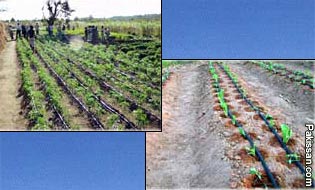|
Main Page
|
![]() |
Crop yield from drip irrigation
By
Dr Adnan Younis & Dr M. Aslam Pervez
TO win acceptance in
markets, the high-value crops such as fruits, vegetables
and flowers must be of top quality. Quality depends on
timely management decisions - especially crop production
inputs. Water, in the form of precipitation or
irrigation, is one of the most critical inputs.
 Rainfall
is unpredictable. Sufficient water supply is a
pre-requisite. Controlling water supply is like
controlling an essential production variable. Irrigation
is the best available technique in meeting the crop’s
water requirement in times of inadequate rainfall. Rainfall
is unpredictable. Sufficient water supply is a
pre-requisite. Controlling water supply is like
controlling an essential production variable. Irrigation
is the best available technique in meeting the crop’s
water requirement in times of inadequate rainfall.
Drip irrigation is the process of applying the right
amount of water slowly and evenly to roots. It is a slow
delivery system in which water can be applied, drop by
drop to the soil surface near the base of a plant.
A properly designed automatic system can remove much
guessing about when to irrigate and how much water to
apply. Water is applied whenever the sensor indicates a
sub-optimum soil moisture level. This keeps the level of
moisture within the optimum range for healthy growth and
minimum stress.
Automatic Drip Irrigation is a valuable tool for
accurate soil moisture control in highly specialized
farming. Total automation of drip irrigation offers a
simple, precise method for sensing soil moisture and
applying water. Management time savings and the removal
of human error in estimating and adjusting the levels
enable skilled growers to maximise the net profits.
Drip irrigation pinpoints water placement and adjusts
delivery rates to the changing needs of each plant.
Fertilizers, using an inline injector, can be delivered
in solution to root zones of the intended plants,
increasing their response rate to feeding.
A drip system saves time. Timers can be installed to
ensure that watering is done at the right time and in
desired amount. Drip system saves more water than with
conventional methods of watering. It lowers the bill.
The payback period for lower water bills and the value
of labour are usually for one season, or less.
Drip irrigation is a total crop support system which
rewards the farmer with higher yields, lower costs, and
the premium quality products. The slow, regular, uniform
application of water and nutrients results in even
growth and ripening with consistent quality. Drip
irrigation, particularly when combined with mulching,
helps break the cycle of too-wet-too-dry soils that
stress plants and retard their growth.
By pinpointing water to individual plants, it remains
unavailable to weeds. The most tedious part in farming
is weeding which gets minimised. The application
efficiency for irrigation systems is relatively high.
This is not due to a good management but mainly due to
the shortage of water in the most irrigated areas.
Drip and sprinkler irrigation methods have an
application efficiency of 84 per cent and 73 per cent
for both systems, respectively which are within the
range of attainable efficiency. Low application
efficiency for flooding irrigation (55 per cent) is due
to high evaporation, seepage losses and unavoidable
losses.
The return to water use for vegetable crops under
plastic houses can be increased if the quantity applied
achieved the ideal amounts. It is still higher than
other agricultural pattern. This is related to
substantial improvements in the levels of production
technology such as planting improved crop varieties,
using drip irrigation techniques and applying
fertilisers and pesticides.
In Pakistan, there is a lack of extension services to
work with farmers to improve the operation and
maintenance of irrigation systems. Pressurised systems
like drip irrigation require a much higher level of
knowledge on the part of the farmer to achieve high
efficiency. It is economic to convert from surface to
drip irrigation system.
Although the cost of drip irrigation system is high in
addition to the training costs of farmers but it remains
much lower than the cost of water and the farmers can
repay the loan with increased production.
Good water management is the most important alternative
to increasing economic revenues, that is, increasing the
production per each unit volume of the water applied for
irrigation. In order to increase the irrigation water
conveyance and distribution systems efficiency, the
canal irrigation systems must be replaced with piped
systems.
Using of minute irrigation technology which refer to low
application rate of irrigation water. Such technologies
allow the infiltration of all the irrigation water into
the soil without runoff, even in heavy soils where
infiltration capacity is extremely low: a very slow and
continuous water movement down the soil profile is
achieved.
At the same time, a favourable environment for root
development is maintained with only minute fluctuations
in soil moisture during the intervals between
irrigations. Such conditions seem to be optimal for
plant growth and may contribute to higher production and
more efficient water use.
Courtesy: The DAWN |
|
Pakissan.com;
|
|
|